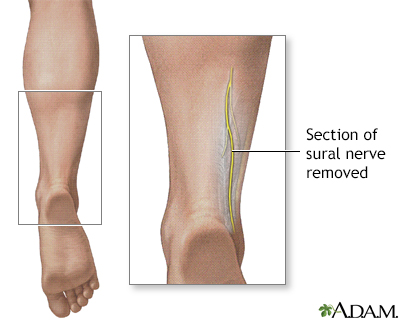Nerve biopsy
Biopsy - nerve
A nerve biopsy is the removal of a small piece of a nerve for examination.

Nerve biopsy is the removal of a small piece of nerve for examination. Through a small incision, a sample of nerve is removed and examined under a microscope. Nerve biopsy may be performed to identify nerve degeneration, identify inflammatory nerve conditions (neuropathies), or to confirm specific diagnoses.
How the Test is Performed
A nerve biopsy is most often done on a nerve in the ankle called the sural nerve. Other sites may be used, depending on the test.
Your health care provider applies numbing medicine (local anesthetic) to the area before the procedure. The provider makes a small surgical cut and removes a piece of the nerve. The cut is then closed and a bandage is put on it. The nerve sample is sent to a lab, where it is examined under a microscope.
How to Prepare for the Test
Follow your provider's instructions on how to prepare for the procedure.
How the Test will Feel
When the numbing medicine is injected, you will feel a prick and a mild sting. The biopsy site may be sore for a few days after the test.
Why the Test is Performed
Nerve biopsy may be done to help diagnose:
- Axon degeneration (destruction of the axon portion of the nerve cell)
- Damage to the small nerves
- Demyelination (destruction of parts of the myelin sheath covering the nerve)
- Inflammatory nerve conditions (neuropathies)
Nerve biopsy is usually done to look for inflammation that could be damaging the nerve. Conditions for which the test may be done include any of the following:
- Mononeuritis multiplex (disorder that involves damage to at least two separate nerve areas)
- Necrotizing vasculitis (group of disorders that involve inflammation of the blood vessel walls)
- Neurosarcoidosis (complication of sarcoidosis, in which inflammation occurs in the brain, spinal cord, and other areas of the nervous system)
- Abnormal protein deposits on the nerve (amyloid)
- Vasculitis of the nerve
- Suspected tumor of the nerve
Normal Results
A normal result means the nerve appears normal.
What Abnormal Results Mean
Abnormal results may be due to:
- Amyloidosis (sural nerve biopsy is most often used)
- Demyelination
- Inflammation of the nerve
- Infections that damage nerves
- Loss of axon tissue
- Metabolic neuropathies (nerve disorders that occur with diseases that disrupt the chemical processes in the body)
- Necrotizing vasculitis
- Sarcoidosis
Risks
Risks of the procedure may include:
- Allergic reaction to the local anesthetic
- Discomfort after the procedure
- Infection (a slight risk any time the skin is broken)
- Permanent nerve damage (uncommon; minimized by careful site selection). A small patch of skin may be permanently numb afterwards.
Nerve biopsy is invasive and is useful only in certain situations. Talk to your provider about your options.
Considerations
References
Katirji B. Disorders of peripheral nerves. In: Jankovic J, Mazziotta JC, Pomeroy SL, Newman NJ, eds. Bradley and Daroff's Neurology in Clinical Practice. 8th ed. Philadelphia, PA: Elsevier; 2022:chap 106.
Umansky D, Midha R. Peripheral nerve examination, evaluation, and biopsy. In: Winn HR, ed. Youmans and Winn Neurological Surgery. 8th ed. Philadelphia, PA: Elsevier; 2023:chap 272.
Version Info
Last reviewed on: 4/29/2023
Reviewed by: Joseph V. Campellone, MD, Department of Neurology, Cooper Medical School of Rowan University, Camden, NJ. Review provided by VeriMed Healthcare Network. Also reviewed by David C. Dugdale, MD, Medical Director, Brenda Conaway, Editorial Director, and the A.D.A.M. Editorial team.
